

Compact Muon Solenoid
LHC, CERN
| CMS-MUO-21-001 ; CERN-EP-2024-040 | ||
| Performance of CMS muon reconstruction from proton-proton to heavy ion collisions | ||
| CMS Collaboration | ||
| 26 April 2024 | ||
| JINST 19 (2024) P09012 | ||
| Abstract: The performance of muon tracking, identification, triggering, momentum resolution, and momentum scale has been studied with the CMS detector at the LHC using data collected at $ \sqrt{\smash[b]{s_{_{\mathrm{NN}}}}}= $ 5.02 TeV in proton-proton (pp) and lead-lead (PbPb) collisions in 2017 and 2018, respectively, and at $ \sqrt{\smash[b]{s_{_{\mathrm{NN}}}}} = $ 8.16 TeV in proton-lead (pPb) collisions in 2016. Muon efficiencies, momentum resolutions, and momentum scales are compared by focusing on how the muon reconstruction performance varies from relatively small occupancy pp collisions to the larger occupancies of pPb collisions and, finally, to the highest track multiplicity PbPb collisions. We find the efficiencies of muon tracking, identification, and triggering to be above 90% throughout most of the track multiplicity range. The momentum resolution and scale are unaffected by the detector occupancy. The excellent muon reconstruction of the CMS detector enables precision studies across all available collision systems. | ||
| Links: e-print arXiv:2404.17377 [hep-ex] (PDF) ; CDS record ; inSPIRE record ; Physics Briefing ; CADI line (restricted) ; | ||
| Figures | |
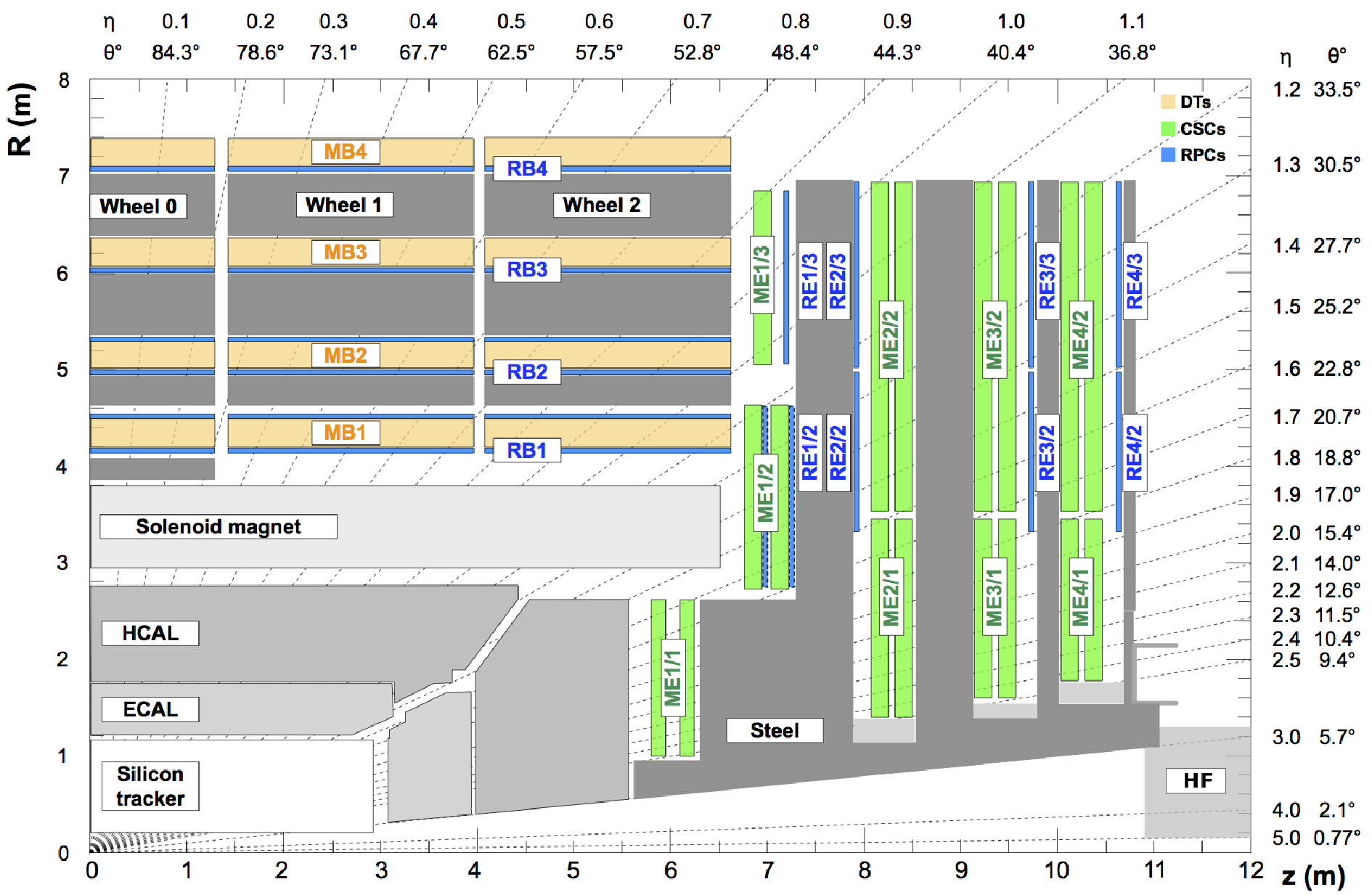
png pdf |
Figure 1:
Longitudinal layout of one quadrant of the CMS detector. The drawing shows four DT stations in the muon barrel (MB1-MB4, yellow), four CSC stations in the muon endcap (ME1-ME4, green) and the RPC stations (RB1-RB4 and RE1-RE4, blue). |
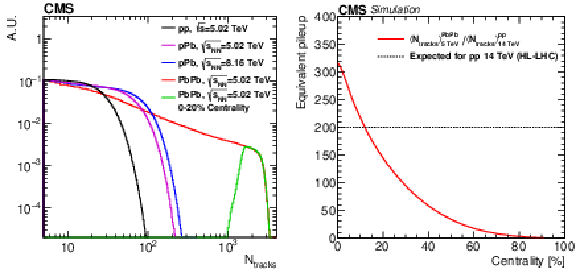
png pdf |
Figure 2:
Left: Distribution of $ N_{\mathrm{tracks}} $ in pp collisions at $ \sqrt{s}= $ 5.02 TeV (black); pPb collisions at $ \sqrt{\smash[b]{s_{_{\mathrm{NN}}}}}= $ 5.02 TeV (magenta) and at 8.16 TeV (blue); and PbPb collisions at $ \sqrt{\smash[b]{s_{_{\mathrm{NN}}}}}= $ 5.02 TeV (red). The distribution of $ N_{\mathrm{tracks}} $ in the 0-20% most central PbPb collisions is shown in green. The values are not corrected for efficiency. Right: Translation of the centrality in PbPb collisions at $ \sqrt{\smash[b]{s_{_{\mathrm{NN}}}}}= $ 5.02 TeV into an equivalent pileup in pp collisions at $ \sqrt{s}= $ 14 TeV. |

png pdf |
Figure 2-a:
Left: Distribution of $ N_{\mathrm{tracks}} $ in pp collisions at $ \sqrt{s}= $ 5.02 TeV (black); pPb collisions at $ \sqrt{\smash[b]{s_{_{\mathrm{NN}}}}}= $ 5.02 TeV (magenta) and at 8.16 TeV (blue); and PbPb collisions at $ \sqrt{\smash[b]{s_{_{\mathrm{NN}}}}}= $ 5.02 TeV (red). The distribution of $ N_{\mathrm{tracks}} $ in the 0-20% most central PbPb collisions is shown in green. The values are not corrected for efficiency. Right: Translation of the centrality in PbPb collisions at $ \sqrt{\smash[b]{s_{_{\mathrm{NN}}}}}= $ 5.02 TeV into an equivalent pileup in pp collisions at $ \sqrt{s}= $ 14 TeV. |
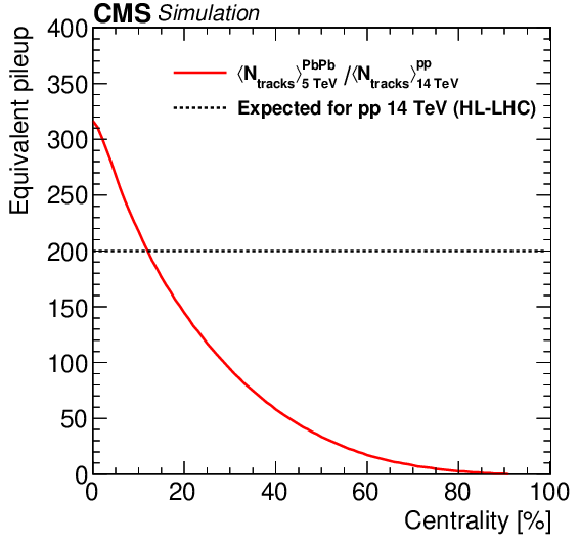
png pdf |
Figure 2-b:
Left: Distribution of $ N_{\mathrm{tracks}} $ in pp collisions at $ \sqrt{s}= $ 5.02 TeV (black); pPb collisions at $ \sqrt{\smash[b]{s_{_{\mathrm{NN}}}}}= $ 5.02 TeV (magenta) and at 8.16 TeV (blue); and PbPb collisions at $ \sqrt{\smash[b]{s_{_{\mathrm{NN}}}}}= $ 5.02 TeV (red). The distribution of $ N_{\mathrm{tracks}} $ in the 0-20% most central PbPb collisions is shown in green. The values are not corrected for efficiency. Right: Translation of the centrality in PbPb collisions at $ \sqrt{\smash[b]{s_{_{\mathrm{NN}}}}}= $ 5.02 TeV into an equivalent pileup in pp collisions at $ \sqrt{s}= $ 14 TeV. |
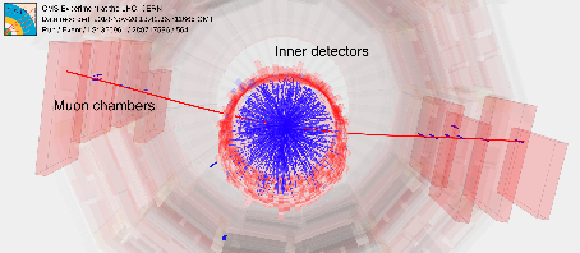
png pdf |
Figure 3:
Dimuon event from a PbPb collision in the CMS detector. Particles reconstructed in the inner tracker are colored blue; two muons from a Z boson candidate are colored red. See text for details. |

png pdf |
Figure 4:
Example of a fit to the data in PbPb collisions. The three panels show invariant mass distributions of the tag-and-probe pairs in central 0-10% collisions fitted with the sum of signal and background components. Left panel: total spectrum. Middle panel: spectrum for pairs where the probe passed the muon identification selection. Right panel: spectrum for muon pairs where the probe failed the selection. The vertical scale of the failing probes is enhanced by a factor of 5 compared with the other panels for visibility. The efficiency is retrieved directly from the simultaneous fit and in this particular case is $ \epsilon = $ 0.968 $ \pm $ 0.002. |
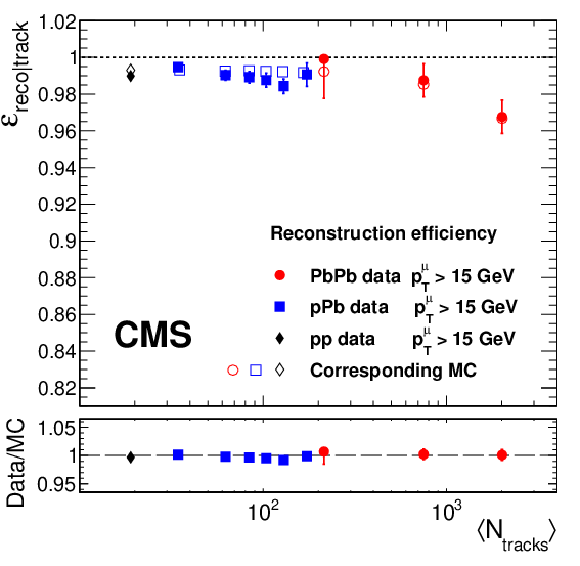
png pdf |
Figure 5:
Muon reconstruction efficiency (defined as the probability that a given muon that produced a tracker track will be reconstructed as both a global and a PF muon) plotted as a function of the number of tracks in pp, pPb, and PbPb collisions. Open symbols are the MC results corresponding to each data set. Lower panel shows the ratio between data and MC simulation. Only statistical uncertainties are shown. |

png pdf |
Figure 6:
Tight ID efficiency for global and PF muons as a function of the number of tracks in pp, pPb, and PbPb collisions. Open symbols are the MC results corresponding to each data set. Lower panel shows the ratio between data and MC simulation. Only statistical uncertainties are shown. |

png pdf |
Figure 7:
Tight ID efficiency as a function of $ \eta $ (left) and $ p_{\mathrm{T}} $ (right) in pp, pPb, and PbPb collisions. The probe is both a global muon and a PF muon. Open symbols are the MC results corresponding to each data set. Lower panels show the ratio between data and MC simulation. Only statistical uncertainties are shown. |
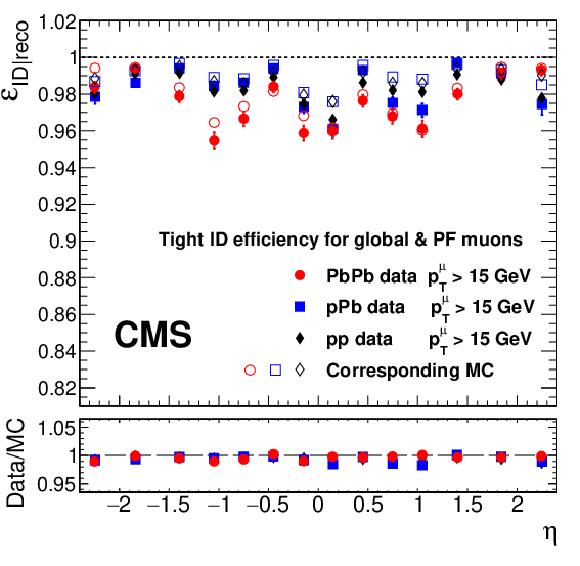
png pdf |
Figure 7-a:
Tight ID efficiency as a function of $ \eta $ (left) and $ p_{\mathrm{T}} $ (right) in pp, pPb, and PbPb collisions. The probe is both a global muon and a PF muon. Open symbols are the MC results corresponding to each data set. Lower panels show the ratio between data and MC simulation. Only statistical uncertainties are shown. |
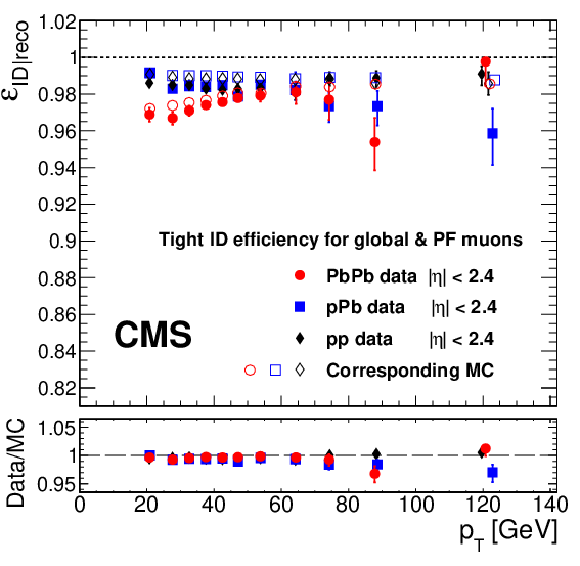
png pdf |
Figure 7-b:
Tight ID efficiency as a function of $ \eta $ (left) and $ p_{\mathrm{T}} $ (right) in pp, pPb, and PbPb collisions. The probe is both a global muon and a PF muon. Open symbols are the MC results corresponding to each data set. Lower panels show the ratio between data and MC simulation. Only statistical uncertainties are shown. |
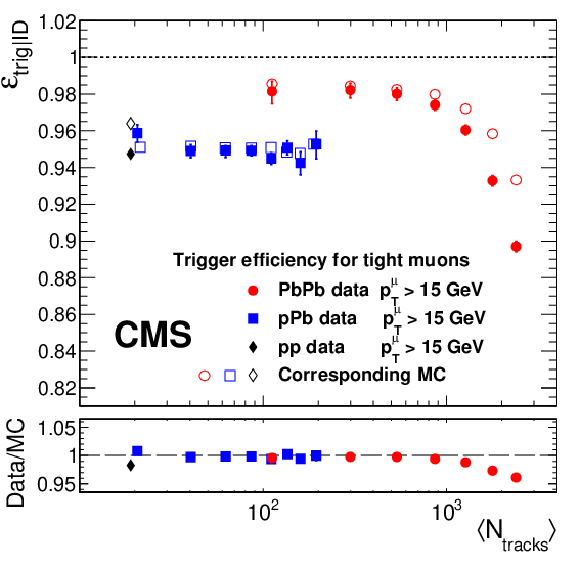
png pdf |
Figure 8:
Trigger efficiency of tight muons as a function of the number of tracks. The trigger requires a single muon with $ p_{\mathrm{T}} $ above 12 GeV. The efficiency is calculated for muons with $ p_{\mathrm{T}} > $ 15 GeV to avoid threshold effects. Open symbols are the MC results corresponding to each data set. Lower panel shows the ratio between data and MC simulation. Only statistical uncertainties are shown. |
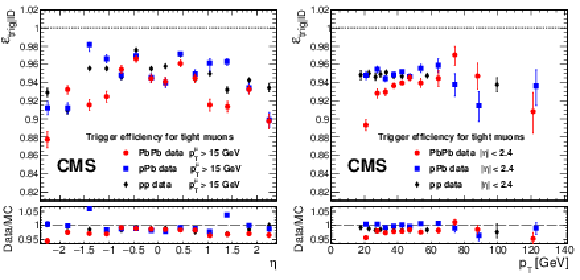
png pdf |
Figure 9:
Trigger efficiency of tight muons as a function of $ \eta $ (left) and $ p_{\mathrm{T}} $ (right) in pp, pPb, and PbPb collisions. Lower panels show the ratio between data and MC simulation (MC points are omitted in the upper panels for clarity). Only statistical uncertainties are shown. |
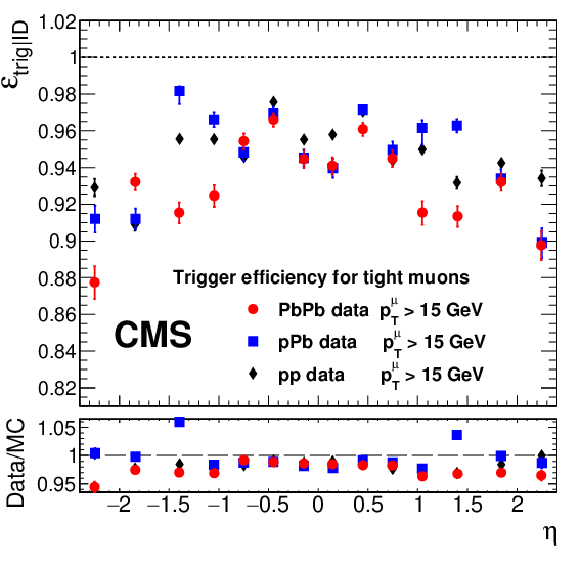
png pdf |
Figure 9-a:
Trigger efficiency of tight muons as a function of $ \eta $ (left) and $ p_{\mathrm{T}} $ (right) in pp, pPb, and PbPb collisions. Lower panels show the ratio between data and MC simulation (MC points are omitted in the upper panels for clarity). Only statistical uncertainties are shown. |
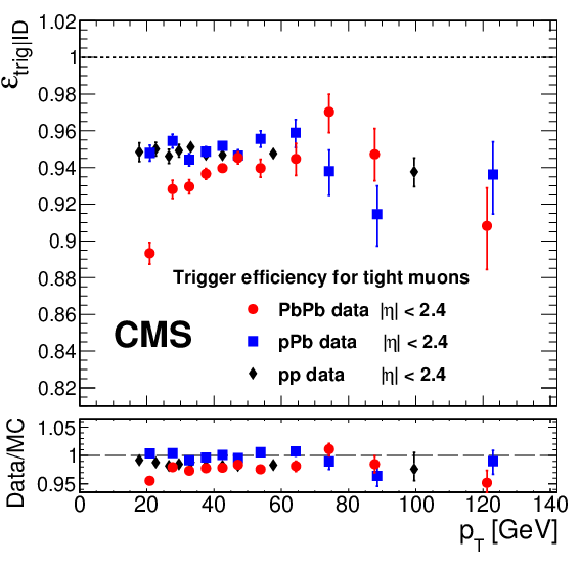
png pdf |
Figure 9-b:
Trigger efficiency of tight muons as a function of $ \eta $ (left) and $ p_{\mathrm{T}} $ (right) in pp, pPb, and PbPb collisions. Lower panels show the ratio between data and MC simulation (MC points are omitted in the upper panels for clarity). Only statistical uncertainties are shown. |
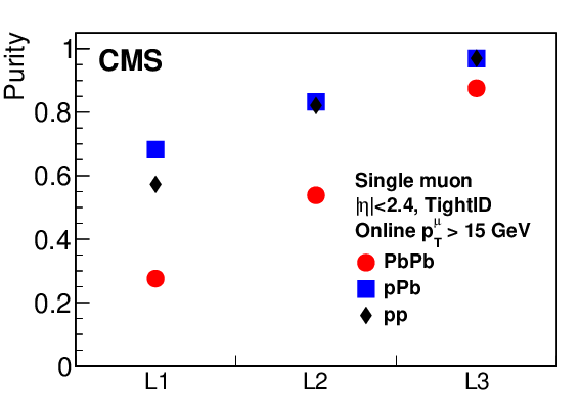
png pdf |
Figure 10:
Purity for the L1, L2, and L3 trigger steps, compared among pp, pPb, and PbPb collisions. The online muon must have $ p_{\mathrm{T}} > $ 15 GeV and the offline muon matched to it must pass the tight ID selection and have $ |\eta| < $ 2.4. Details of the purity definition are given in the text. Statistical uncertainties are smaller than the symbol sizes. |
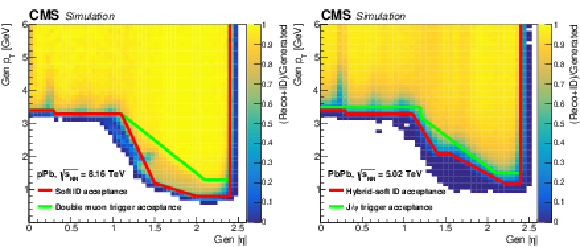
png pdf |
Figure 11:
Regions of the CMS detector commonly used in the heavy ion muon analyses for pPb (left) and PbPb (right) collisions. For each panel, the combined reconstruction and identification efficiency for simulated muons is plotted as a function of generated muon $ |\eta| $ and $ p_{\mathrm{T}} $. The lower-threshold curves (red) are for muon identification, and are used only by those analyses that do not use a dedicated muon trigger. The higher-threshold curves (green) are used by most analyses (those using the muon trigger information). |
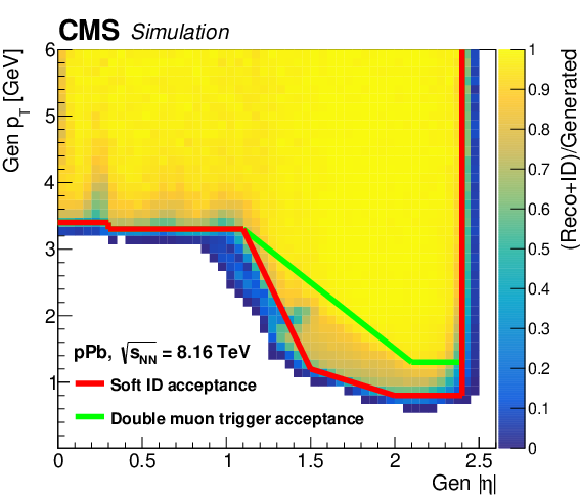
png pdf |
Figure 11-a:
Regions of the CMS detector commonly used in the heavy ion muon analyses for pPb (left) and PbPb (right) collisions. For each panel, the combined reconstruction and identification efficiency for simulated muons is plotted as a function of generated muon $ |\eta| $ and $ p_{\mathrm{T}} $. The lower-threshold curves (red) are for muon identification, and are used only by those analyses that do not use a dedicated muon trigger. The higher-threshold curves (green) are used by most analyses (those using the muon trigger information). |
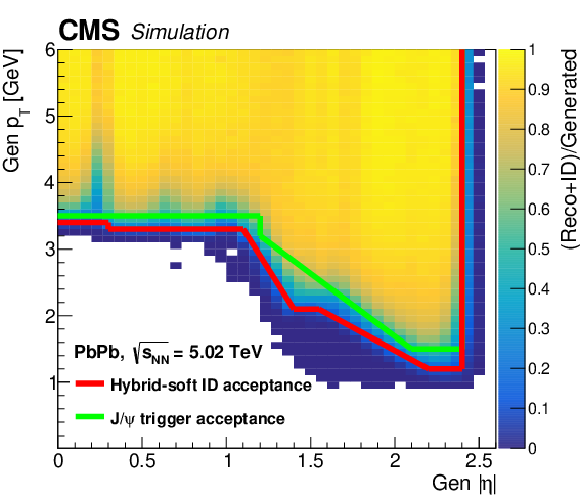
png pdf |
Figure 11-b:
Regions of the CMS detector commonly used in the heavy ion muon analyses for pPb (left) and PbPb (right) collisions. For each panel, the combined reconstruction and identification efficiency for simulated muons is plotted as a function of generated muon $ |\eta| $ and $ p_{\mathrm{T}} $. The lower-threshold curves (red) are for muon identification, and are used only by those analyses that do not use a dedicated muon trigger. The higher-threshold curves (green) are used by most analyses (those using the muon trigger information). |
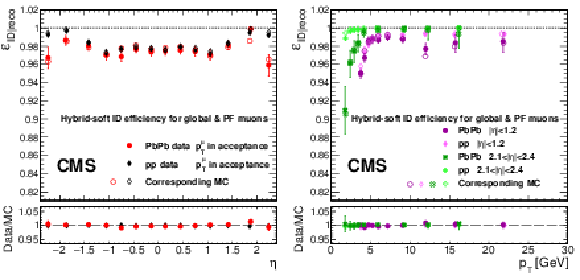
png pdf |
Figure 12:
Hybrid-soft ID efficiency for global muons as a function of $ \eta $ (left) and $ p_{\mathrm{T}} $ (right) in pp and PbPb collisions. The muons are restricted in acceptance as shown by the red line in the right panel of Fig. 11. Lower panels show the ratio between data and MC simulation. Only statistical uncertainties are shown. |
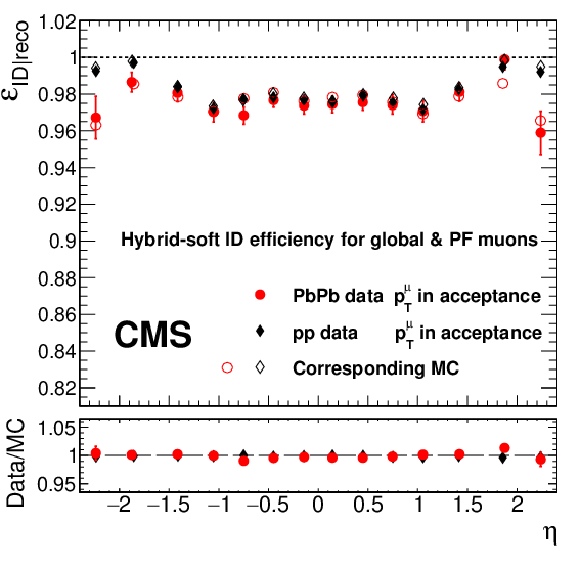
png pdf |
Figure 12-a:
Hybrid-soft ID efficiency for global muons as a function of $ \eta $ (left) and $ p_{\mathrm{T}} $ (right) in pp and PbPb collisions. The muons are restricted in acceptance as shown by the red line in the right panel of Fig. 11. Lower panels show the ratio between data and MC simulation. Only statistical uncertainties are shown. |
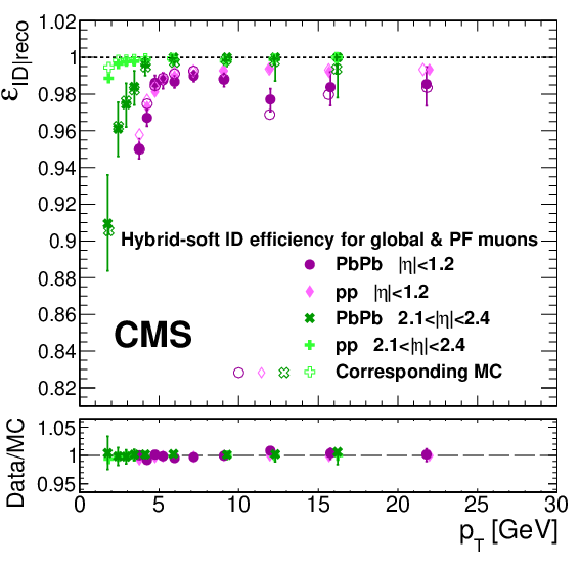
png pdf |
Figure 12-b:
Hybrid-soft ID efficiency for global muons as a function of $ \eta $ (left) and $ p_{\mathrm{T}} $ (right) in pp and PbPb collisions. The muons are restricted in acceptance as shown by the red line in the right panel of Fig. 11. Lower panels show the ratio between data and MC simulation. Only statistical uncertainties are shown. |

png pdf |
Figure 13:
Mass resolution at the Z boson peak (left) and the $ \mathrm{J}/\psi $ peak (right) as a function of the number of tracks from MC simulations (open points) and collision data (filled points) in pp, pPb, and PbPb collisions. The mass resolution is scaled by the world-average mass $ m_{\textrm{PDG}} $. Lower panels show the ratio between data and MC simulation. Only statistical uncertainties are shown. |
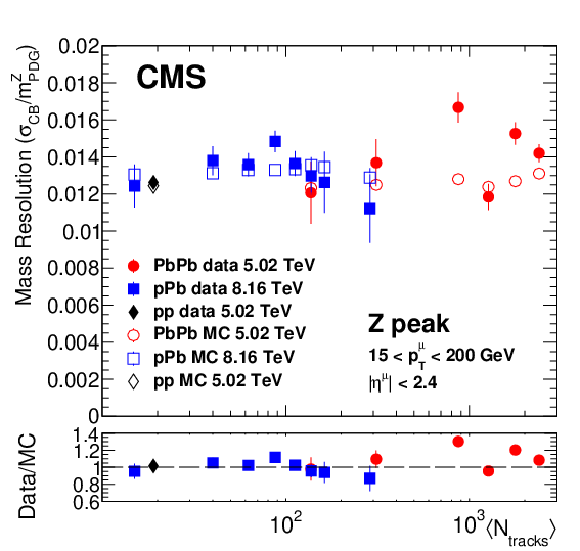
png pdf |
Figure 13-a:
Mass resolution at the Z boson peak (left) and the $ \mathrm{J}/\psi $ peak (right) as a function of the number of tracks from MC simulations (open points) and collision data (filled points) in pp, pPb, and PbPb collisions. The mass resolution is scaled by the world-average mass $ m_{\textrm{PDG}} $. Lower panels show the ratio between data and MC simulation. Only statistical uncertainties are shown. |
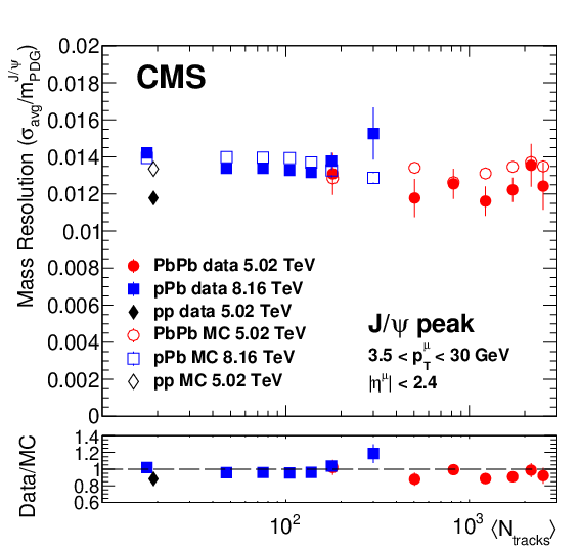
png pdf |
Figure 13-b:
Mass resolution at the Z boson peak (left) and the $ \mathrm{J}/\psi $ peak (right) as a function of the number of tracks from MC simulations (open points) and collision data (filled points) in pp, pPb, and PbPb collisions. The mass resolution is scaled by the world-average mass $ m_{\textrm{PDG}} $. Lower panels show the ratio between data and MC simulation. Only statistical uncertainties are shown. |
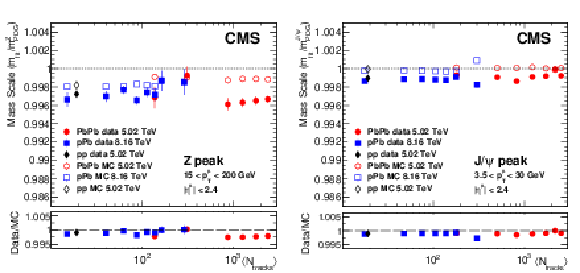
png pdf |
Figure 14:
Mass scale at the Z boson peak (left) and the $ \mathrm{J}/\psi $ peak (right) as a function of the number of tracks from MC simulations (open points) and collision data (filled points) in pp, pPb, and PbPb collisions, calculated as the measured mass $ m_{\textrm{fit}} $ divided by the world-average mass $ m_{\textrm{PDG}} $. Lower panels show the ratio between data and MC simulation. Only statistical uncertainties are shown. |
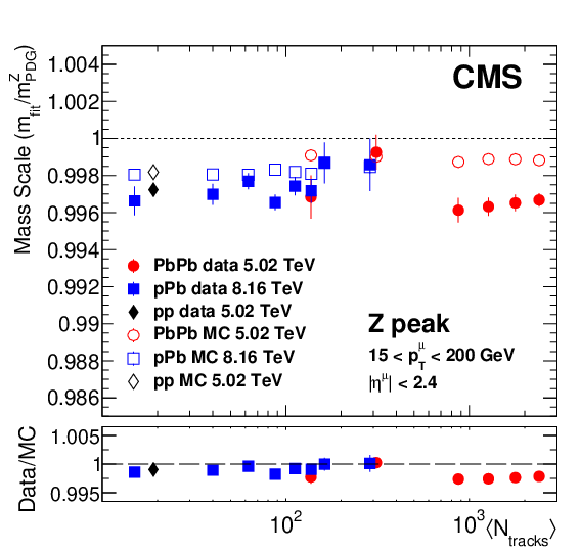
png pdf |
Figure 14-a:
Mass scale at the Z boson peak (left) and the $ \mathrm{J}/\psi $ peak (right) as a function of the number of tracks from MC simulations (open points) and collision data (filled points) in pp, pPb, and PbPb collisions, calculated as the measured mass $ m_{\textrm{fit}} $ divided by the world-average mass $ m_{\textrm{PDG}} $. Lower panels show the ratio between data and MC simulation. Only statistical uncertainties are shown. |
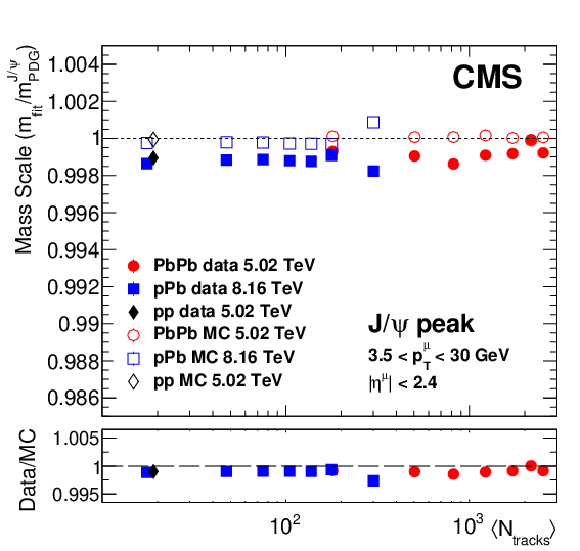
png pdf |
Figure 14-b:
Mass scale at the Z boson peak (left) and the $ \mathrm{J}/\psi $ peak (right) as a function of the number of tracks from MC simulations (open points) and collision data (filled points) in pp, pPb, and PbPb collisions, calculated as the measured mass $ m_{\textrm{fit}} $ divided by the world-average mass $ m_{\textrm{PDG}} $. Lower panels show the ratio between data and MC simulation. Only statistical uncertainties are shown. |

png pdf |
Figure 15:
Mass resolution at the Z boson peak (left) and $ \mathrm{J}/\psi $ peak (right) as a function of $ |y^{\mu\mu}| $ from MC simulations (open points) and collision data (filled points) in pp, pPb, and PbPb collisions. The mass resolution is scaled by the world-average mass $ m_{\textrm{PDG}} $. Lower panels show the ratio between data and MC simulation. Only statistical uncertainties are shown. |
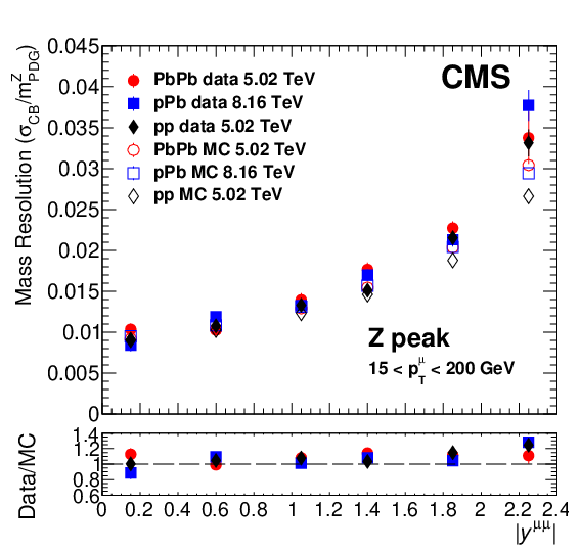
png pdf |
Figure 15-a:
Mass resolution at the Z boson peak (left) and $ \mathrm{J}/\psi $ peak (right) as a function of $ |y^{\mu\mu}| $ from MC simulations (open points) and collision data (filled points) in pp, pPb, and PbPb collisions. The mass resolution is scaled by the world-average mass $ m_{\textrm{PDG}} $. Lower panels show the ratio between data and MC simulation. Only statistical uncertainties are shown. |
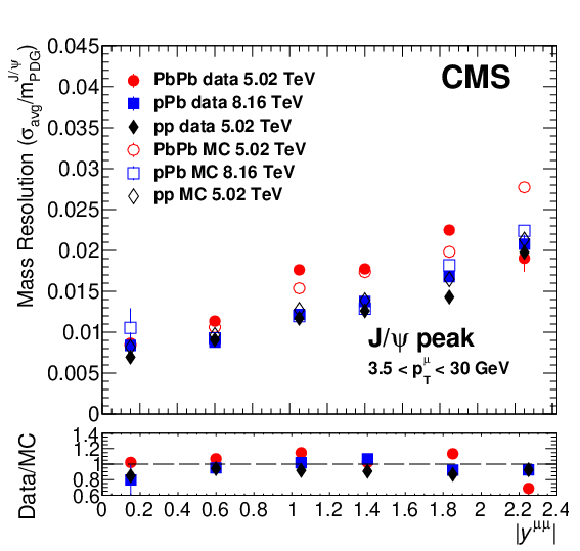
png pdf |
Figure 15-b:
Mass resolution at the Z boson peak (left) and $ \mathrm{J}/\psi $ peak (right) as a function of $ |y^{\mu\mu}| $ from MC simulations (open points) and collision data (filled points) in pp, pPb, and PbPb collisions. The mass resolution is scaled by the world-average mass $ m_{\textrm{PDG}} $. Lower panels show the ratio between data and MC simulation. Only statistical uncertainties are shown. |

png pdf |
Figure 16:
Mass scale at the Z boson peak (left) and the $ \mathrm{J}/\psi $ peak (right) as a function of $ |y^{\mu\mu}| $ from MC simulations (open points) and real data (filled points) in pp, pPb, and PbPb collisions, calculated as the measured mass $ m_{\textrm{fit}} $ divided by the PDG mass $ m_{\textrm{PDG}} $. Lower panels show the ratio between data and MC simulation. Only statistical uncertainties are shown. |
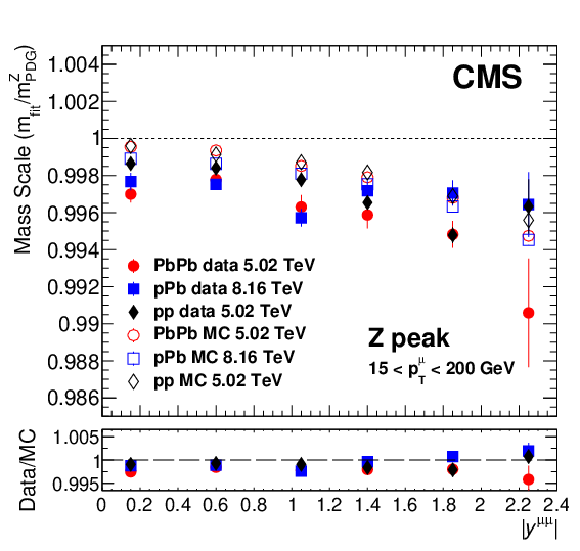
png pdf |
Figure 16-a:
Mass scale at the Z boson peak (left) and the $ \mathrm{J}/\psi $ peak (right) as a function of $ |y^{\mu\mu}| $ from MC simulations (open points) and real data (filled points) in pp, pPb, and PbPb collisions, calculated as the measured mass $ m_{\textrm{fit}} $ divided by the PDG mass $ m_{\textrm{PDG}} $. Lower panels show the ratio between data and MC simulation. Only statistical uncertainties are shown. |
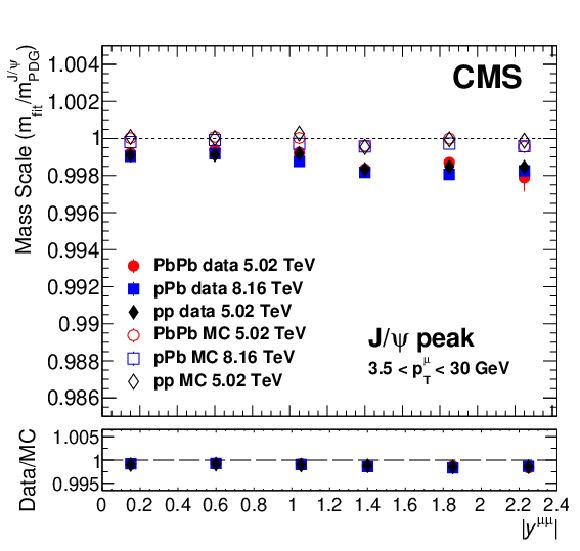
png pdf |
Figure 16-b:
Mass scale at the Z boson peak (left) and the $ \mathrm{J}/\psi $ peak (right) as a function of $ |y^{\mu\mu}| $ from MC simulations (open points) and real data (filled points) in pp, pPb, and PbPb collisions, calculated as the measured mass $ m_{\textrm{fit}} $ divided by the PDG mass $ m_{\textrm{PDG}} $. Lower panels show the ratio between data and MC simulation. Only statistical uncertainties are shown. |
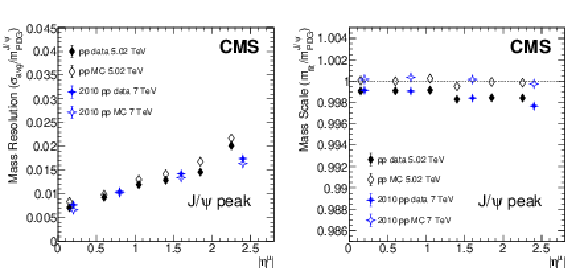
png pdf |
Figure 17:
Mass resolution (left) and mass scale (right) versus the muon pseudorapidity $ |\eta^\mu| $ at the $ \mathrm{J}/\psi $ peak in pp collisions. The values are scaled by the world-average mass $ m^{{\mathrm{J}/\psi} }_{\textrm{PDG}} $. The filled points are collision data and the open points are MC simulations. Our results (black diamonds) are compared with measurements from a previous pp analysis done at $ \sqrt{s}= $ 7 TeV (blue crosses) [40]. Only statistical uncertainties are shown. See details in text. |
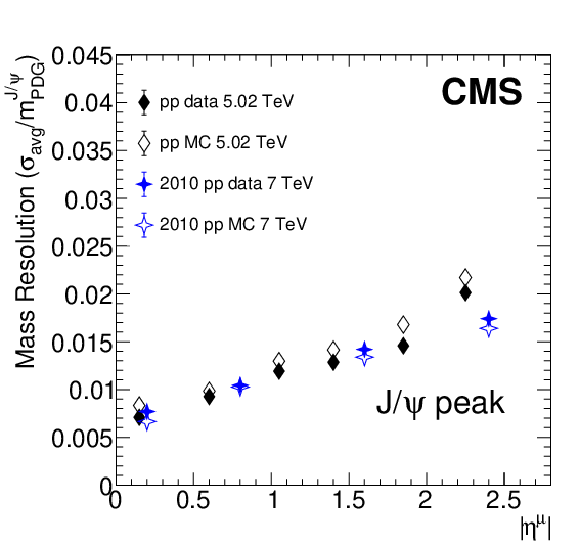
png pdf |
Figure 17-a:
Mass resolution (left) and mass scale (right) versus the muon pseudorapidity $ |\eta^\mu| $ at the $ \mathrm{J}/\psi $ peak in pp collisions. The values are scaled by the world-average mass $ m^{{\mathrm{J}/\psi} }_{\textrm{PDG}} $. The filled points are collision data and the open points are MC simulations. Our results (black diamonds) are compared with measurements from a previous pp analysis done at $ \sqrt{s}= $ 7 TeV (blue crosses) [40]. Only statistical uncertainties are shown. See details in text. |
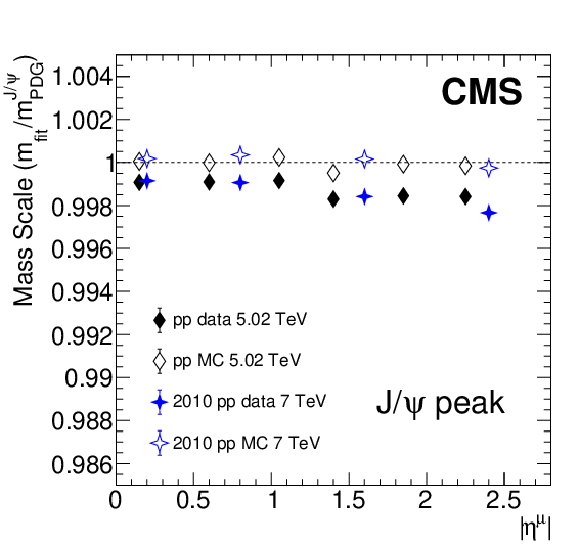
png pdf |
Figure 17-b:
Mass resolution (left) and mass scale (right) versus the muon pseudorapidity $ |\eta^\mu| $ at the $ \mathrm{J}/\psi $ peak in pp collisions. The values are scaled by the world-average mass $ m^{{\mathrm{J}/\psi} }_{\textrm{PDG}} $. The filled points are collision data and the open points are MC simulations. Our results (black diamonds) are compared with measurements from a previous pp analysis done at $ \sqrt{s}= $ 7 TeV (blue crosses) [40]. Only statistical uncertainties are shown. See details in text. |

png pdf |
Figure A1:
Distributions of $ N_{\mathrm{tracks}} $ in the PbPb collisions for various ranges of centrality in a minimum-bias (left) and a muon-triggered (right) data set. |
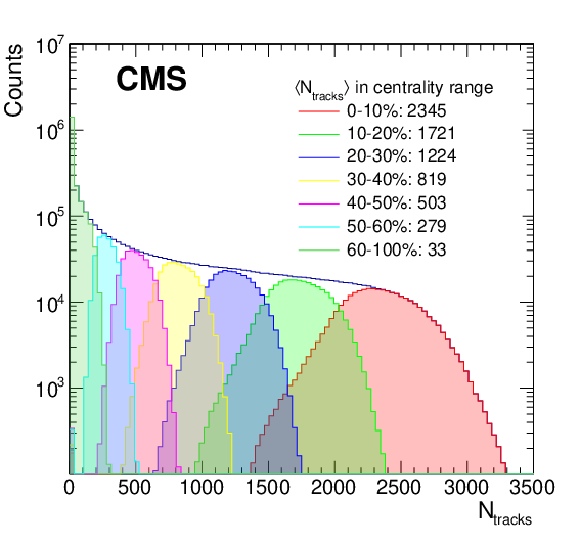
png pdf |
Figure A1-a:
Distributions of $ N_{\mathrm{tracks}} $ in the PbPb collisions for various ranges of centrality in a minimum-bias (left) and a muon-triggered (right) data set. |

png pdf |
Figure A1-b:
Distributions of $ N_{\mathrm{tracks}} $ in the PbPb collisions for various ranges of centrality in a minimum-bias (left) and a muon-triggered (right) data set. |
| Tables | |
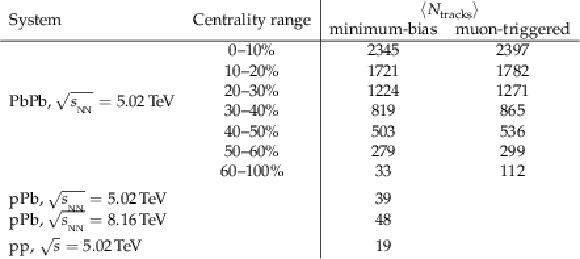
png pdf |
Table 1:
Average number of reconstructed tracks, $ \langle N_{\mathrm{tracks}} \rangle $, in our data sets. The values are not corrected for pileup nor efficiency. Two columns are shown for PbPb collisions. The left column shows the values that are obtained from a minimum-bias data set, and correspond to distributions shown in the left panel of Fig. 2. The right column shows the values in muon-triggered data, and correspond to the location of points shown in the performance plots of this paper. The values for pPb are for illustrative purposes only; pPb results are binned directly in $ N_{\mathrm{tracks}} $. Details of the centrality conversion to $ \langle N_{\mathrm{tracks}} \rangle $ are provided in Appendix A. |

png pdf |
Table 2:
Characteristics of selected collisions collected during LHC Run 2. More information on the corresponding luminosity measurements can be found in Refs. [23-26]. |

png pdf |
Table 3:
Overview of muon identification and triggers used in the Z boson kinematic region (e.g., Z, W, and t analyses) and in the $ \mathrm{J}/\psi $ kinematic region (e.g., $ \mathrm{J}/\psi $ and $ \Upsilon $ analyses). A description of muon identification and triggers is given in the text. |
| Summary |
| We have presented efficiencies of muon reconstruction, identification, and triggering, as well as measurements of the dimuon mass scale and resolution of the CMS detector. The efficiencies were estimated using the data-driven tag-and-probe technique. Mass scale and resolution were derived through fits to the invariant mass spectra of $ \mathrm{J}/\psi $ and Z boson resonances. We have extended previous studies of the muon performance in pp collisions to the heavy ion environment using PbPb data at $ \sqrt{\smash[b]{s_{_{\mathrm{NN}}}}}= $ 5.02 TeV and pPb data at $ \sqrt{\smash[b]{s_{_{\mathrm{NN}}}}}= $ 8.16 TeV. All the results were also measured in pp data at $ \sqrt{s}= $ 5.02 TeV for comparison across all collision systems as a function of the charged particle multiplicity, $ N_{\mathrm{tracks}} $. The efficiencies are high (typically above 90%) in all cases, even at extremely high occupancy. In the low-$ p_{\mathrm{T}} $ region, the muon-identification efficiency is comparable between pp and PbPb collisions, except in the region of highest occupancy at very low $ p_{\mathrm{T}} $ ($ {<} $ 5 GeV) and forward pseudorapidity ($ |\eta| > $ 2). This drop in efficiency is expected because the high number of tracks in the inner parts of the detector complicates the matching of tracks between the muon chambers and the tracker. In the high-$ p_{\mathrm{T}} $ region, we observe a slight drop (1-2%) in the muon-identification efficiency in the most central PbPb events at multiplicities that are unattainable in pPb or pp events. A slight decrease ($ {\approx}3% $) in the reconstruction efficiency at high occupancies is also observed. Additionally, the trigger efficiency decreases in the most central PbPb events. A relative reduction of $ {\approx}8% $ in the trigger efficiency occurs between the lowest and highest $ N_{\mathrm{tracks}} $ bins in PbPb collisions. This reduction is more pronounced than the corresponding decrease in the muon identification and reconstruction efficiencies, suggesting that the CMS single-muon trigger is more sensitive to detector occupancy. In most cases, the efficiencies calculated using Monte Carlo simulations capture the trends seen in data, indicating that the main features are contained in the detector simulation. In a few instances, the MC efficiencies overestimate those obtained from collision data (by up to 4 percentage points), highlighting the need for independent techniques of efficiency estimation based directly on collision data. The excellent muon performance of the CMS detector has made possible a robust muon and dimuon program in the heavy ion environment, leading to many muon-based measurements, where some examples include heavy quarkonia, heavy-flavor mesons [41,3,42,43,44,45,46,47,48,49,50,51]; and electroweak bosons [33,52,31,53,32]. |
| References | ||||
| 1 | CMS Collaboration | Measurements of inclusive $ W $ and $ Z $ cross sections in pp collisions at $ \sqrt{s}= $ 7 TeV | JHEP 01 (2011) 080 | CMS-EWK-10-002 1012.2466 |
| 2 | CMS Collaboration | Study of W boson production in pPb collisions at $ \sqrt{\smash[b]{s_{_{\mathrm{NN}}}}} = $ 5.02 TeV | PLB 750 (2015) 565 | CMS-HIN-13-007 1503.05825 |
| 3 | CMS Collaboration | Suppression of non-prompt J/$ \psi $, prompt J/$ \psi $, and Y(1S) in PbPb collisions at $ \sqrt{\smash[b]{s_{_{\mathrm{NN}}}}}= $ 2.76 TeV | JHEP 05 (2012) 063 | CMS-HIN-10-006 1201.5069 |
| 4 | CMS Collaboration | Performance of CMS muon reconstruction in pp collision events at $ \sqrt{s}= $ 7 TeV | JINST 7 (2012) P10002 | CMS-MUO-10-004 1206.4071 |
| 5 | CMS Collaboration | Performance of the reconstruction and identification of high-momentum muons in proton-proton collisions at $ \sqrt{s} = $ 13 TeV | JINST 15 (2020) P02027 | CMS-MUO-17-001 1912.03516 |
| 6 | W. Busza, K. Rajagopal, and W. van der Schee | Heavy ion collisions: The big picture, and the big questions | Ann. Rev. Nucl. Part. Sci. 68 (2018) 339 | 1802.04801 |
| 7 | CMS Collaboration | Dependence on pseudorapidity and centrality of charged hadron production in PbPb collisions at a nucleon-nucleon centre-of-mass energy of 2.76 TeV | JHEP 08 (2011) 141 | CMS-HIN-10-001 1107.4800 |
| 8 | CMS Collaboration | The CMS experiment at the CERN LHC | JINST 3 (2008) S08004 | |
| 9 | CMS Collaboration | The CMS trigger system | JINST 12 (2017) P01020 | CMS-TRG-12-001 1609.02366 |
| 10 | CMS Collaboration | Performance of the CMS Level-1 trigger in proton-proton collisions at $ \sqrt{s} = $ 13 TeV | JINST 15 (2020) P10017 | CMS-TRG-17-001 2006.10165 |
| 11 | GEANT4 Collaboration | GEANT 4---a simulation toolkit | NIM A 506 (2003) 250 | |
| 12 | T. Sjöstrand et al. | An introduction to PYTHIA 8.2 | Comput. Phys. Commun. 191 (2015) 159 | 1410.3012 |
| 13 | J. Alwall et al. | The automated computation of tree-level and next-to-leading order differential cross sections, and their matching to parton shower simulations | JHEP 07 (2014) 079 | 1405.0301 |
| 14 | P. Nason | A new method for combining NLO QCD with shower Monte Carlo algorithms | JHEP 11 (2004) 040 | hepph/0409146 |
| 15 | S. Frixione, P. Nason, and C. Oleari | Matching NLO QCD computations with parton shower simulations: the POWHEG method | JHEP 11 (2007) 070 | 0709.2092 |
| 16 | S. Alioli, P. Nason, C. Oleari, and E. Re | A general framework for implementing NLO calculations in shower Monte Carlo programs: the POWHEG BOX | JHEP 06 (2010) 043 | 1002.2581 |
| 17 | S. Alioli, P. Nason, C. Oleari, and E. Re | NLO vector-boson production matched with shower in POWHEG | JHEP 07 (2008) 060 | 0805.4802 |
| 18 | T. Pierog et al. | EPOS LHC: test of collective hadronization with data measured at the CERN Large Hadron Collider | Phys. Rev. C 92 (2015) 034906 | 1306.0121 |
| 19 | I. P. Lokhtin and A. M. Snigirev | A model of jet quenching in ultrarelativistic heavy ion collisions and high-$ p_{\mathrm{T}} $ hadron spectra at RHIC | EPJC 45 (2006) 211 | hepph/0506189 |
| 20 | CMS Tracker Group Collaboration | The CMS Phase-1 pixel detector upgrade | JINST 16 (2021) P02027 | 2012.14304 |
| 21 | CMS Collaboration | Strategies and performance of the CMS silicon tracker alignment during LHC Run 2 | NIM A 1037 (2022) 166795 | CMS-TRK-20-001 2111.08757 |
| 22 | CMS Collaboration | Observation and studies of jet quenching in PbPb collisions at nucleon-nucleon center-of-mass energy = 2.76 TeV | Phys. Rev. C 84 (2011) 024906 | CMS-HIN-10-004 1102.1957 |
| 23 | CMS Collaboration | Precision luminosity measurement in proton-proton collisions at $ \sqrt{s}= $ 13 TeV in 2015 and 2016 at CMS | EPJC 81 (2021) 800 | CMS-LUM-17-003 2104.01927 |
| 24 | CMS Collaboration | CMS luminosity measurement using 2016 proton-nucleus collisions at $ {\sqrt{\smash[b]{s_{_{\mathrm{NN}}}}}} = $ 8.16 TeV | CMS Physics Analysis Summary, 2018 CMS-PAS-LUM-17-002 |
CMS-PAS-LUM-17-002 |
| 25 | CMS Collaboration | Luminosity measurement in proton-proton collisions at 5.02 TeV in 2017 at CMS | CMS Physics Analysis Summary, 2021 CMS-PAS-LUM-19-001 |
CMS-PAS-LUM-19-001 |
| 26 | CMS Collaboration | CMS luminosity measurement using nucleus-nucleus collisions at $ {\sqrt{\smash[b]{s_{_{\mathrm{NN}}}}}} = $ 5.02 TeV in 2018 | CMS Physics Analysis Summary, 2022 CMS-PAS-LUM-18-001 |
CMS-PAS-LUM-18-001 |
| 27 | CMS Collaboration | Performance of the CMS muon trigger system in proton-proton collisions at $ \sqrt{s} = $ 13 TeV | JINST 16 (2021) P07001 | CMS-MUO-19-001 2102.04790 |
| 28 | CMS Collaboration | Description and performance of track and primary-vertex reconstruction with the CMS tracker | JINST 9 (2014) P10009 | CMS-TRK-11-001 1405.6569 |
| 29 | CMS Collaboration | Performance of the CMS muon detector and muon reconstruction with proton-proton collisions at $ \sqrt{s}= $ 13 TeV | JINST 13 (2018) P06015 | CMS-MUO-16-001 1804.04528 |
| 30 | CMS Collaboration | Performance of CMS muon reconstruction in cosmic-ray events | JINST 5 (2010) T03022 | CMS-CFT-09-014 0911.4994 |
| 31 | CMS Collaboration | Particle-flow reconstruction and global event description with the CMS detector | JINST 12 (2017) P10003 | CMS-PRF-14-001 1706.04965 |
| 32 | CMS Collaboration | Constraints on the initial state of PbPb collisions via measurements of Z-boson yields and azimuthal anisotropy at $ \sqrt{\smash[b]{s_{_{\mathrm{NN}}}}}= $ 5.02 TeV | PRL 127 (2021) 102002 | CMS-HIN-19-003 2103.14089 |
| 33 | CMS Collaboration | Using Z boson events to study parton-medium interactions in Pb-Pb collisions | PRL 128 (2022) 122301 | CMS-HIN-19-006 2103.04377 |
| 34 | CMS Collaboration | Study of $ W $ boson production in PbPb and pp collisions at $ \sqrt{\smash[b]{s_{_{\mathrm{NN}}}}}= $ 2.76 TeV | PLB 715 (2012) 66 | CMS-HIN-11-008 1205.6334 |
| 35 | CMS Collaboration | Evidence for top quark production in nucleus-nucleus collisions | PRL 125 (2020) 222001 | CMS-HIN-19-001 2006.11110 |
| 36 | CMS Collaboration | CMS physics: Technical design report volume 1: Detector performance and software | Technical Report CERN-LHCC-2006-001, CMS-TDR-8-1, 2006 CDS |
|
| 37 | CMS Collaboration | Description and performance of track and primary-vertex reconstruction with the CMS tracker | JINST 9 (2014) P10009 | CMS-TRK-11-001 1405.6569 |
| 38 | Particle Data Group, P. A. Zyla et al. | Review of particle physics | Prog. Theor. Exp. Phys. 2020 (2020) 083C01 | |
| 39 | M. J. Oreglia | A study of the reactions $ \psi^\prime \to \gamma \gamma \psi $ | PhD thesis, Stanford University, SLAC Report SLAC-R-236, Appendix D, 1980 link |
|
| 40 | Y. Sun, V. Greco, and X.-N. Wang | Modification of $ Z^0 $ leptonic invariant mass in ultrarelativistic heavy ion collisions as a measure of the electromagnetic field | PLB 827 (2022) 136962 | 2111.01716 |
| 41 | CMS Collaboration | Measurement of momentum scale and resolution of the CMS detector using low-mass resonances and cosmic ray muons | CMS Physics Analysis Summary, 2010 CMS-PAS-TRK-10-004 |
|
| 42 | CMS Collaboration | Indications of suppression of excited $ \Upsilon $ states in PbPb collisions at $ \sqrt{\smash[b]{s_{_{\mathrm{NN}}}}} $ = 2.76 TeV | PRL 107 (2011) 052302 | CMS-HIN-11-007 1105.4894 |
| 43 | CMS Collaboration | Observation of sequential $ \Upsilon $ suppression in PbPb collisions | PRL 109 (2012) 222301 | CMS-HIN-11-011 1208.2826 |
| 44 | CMS Collaboration | Measurement of prompt $ \psi(2S) \to \mathrm{J}/\psi $ yield ratios in PbPb and pp collisions at $ \sqrt{\smash[b]{s_{_{\mathrm{NN}}}}}= $ 2.76 TeV | PRL 113 (2014) 262301 | CMS-HIN-12-007 1410.1804 |
| 45 | CMS Collaboration | Relative modification of prompt $\psi$(2S) and J/$\psi$ yields from pp to PbPb collisions at $ \sqrt{\smash[b]{s_{_{\mathrm{NN}}}}}= $ 5.02 TeV | PRL 118 (2017) 162301 | CMS-HIN-16-004 1611.01438 |
| 46 | CMS Collaboration | Suppression of $ \Upsilon(1S), \Upsilon(2S) $ and $ \Upsilon(3S) $ production in PbPb collisions at $ \sqrt{\smash[b]{s_{_{\mathrm{NN}}}}} $ = 2.76 TeV | PLB 770 (2017) 357 | CMS-HIN-15-001 1611.01510 |
| 47 | CMS Collaboration | Suppression and azimuthal anisotropy of prompt and nonprompt $ {\mathrm{J}}/\psi $ production in PbPb collisions at $ \sqrt{\smash[b]{s_{_{\mathrm{NN}}}}} = $ 2.76 TeV | EPJC 77 (2017) 252 | CMS-HIN-14-005 1610.00613 |
| 48 | CMS Collaboration | Suppression of excited $ \Upsilon $ states relative to the ground state in PbPb collisions at $ \sqrt{\smash[b]{s_{_{\mathrm{NN}}}}}= $ 5.02 TeV | PRL 120 (2018) 142301 | CMS-HIN-16-008 1706.05984 |
| 49 | CMS Collaboration | Measurement of prompt and nonprompt charmonium suppression in PbPb collisions at 5.02 $ \,\text {Te}\text {V} $ | EPJC 78 (2018) 509 | CMS-HIN-16-025 1712.08959 |
| 50 | CMS Collaboration | Measurement of nuclear modification factors of $ \Upsilon $(1S), $ \Upsilon $(2S), and $ \Upsilon $(3S) mesons in PbPb collisions at $ \sqrt{\smash[b]{s_{_{\mathrm{NN}}}}} = $ 5.02 TeV | PLB 790 (2019) 270 | CMS-HIN-16-023 1805.09215 |
| 51 | CMS Collaboration | Measurement of the azimuthal anisotropy of $ \Upsilon(1S) $ and $ \Upsilon(2S) $ mesons in PbPb collisions at $ \sqrt{\smash[b]{s_{_{\mathrm{NN}}}}} = $ 5.02 TeV | PLB 819 (2021) 136385 | CMS-HIN-19-002 2006.07707 |
| 52 | CMS Collaboration | Observation of the $ B_c^+ $ meson in Pb-Pb and pp collisions at $ \sqrt{\smash[b]{s_{_{\mathrm{NN}}}}} =$ 5.02 TeV and measurement of its nuclear modification factor | PRL 128 (2022) 252301 | CMS-HIN-20-004 2201.02659 |
| 53 | CMS Collaboration | Study of jet quenching with $ Z+\text{jet} $ correlations in PbPb and pp collisions at $ {\sqrt{\smash[b]{s_{_{\mathrm{NN}}}}}=5.02}\,\mathrm{TeV} $ | PRL 119 (2017) 082301 | CMS-HIN-15-013 1702.01060 |
| 54 | CMS Collaboration | Study of Z boson production in PbPb collisions at $ \sqrt{\smash[b]{s_{_{\mathrm{NN}}}}} $ = 2.76 TeV | PRL 106 (2011) 212301 | CMS-HIN-10-003 1102.5435 |

|
Compact Muon Solenoid LHC, CERN |

|

|

|

|

|

|